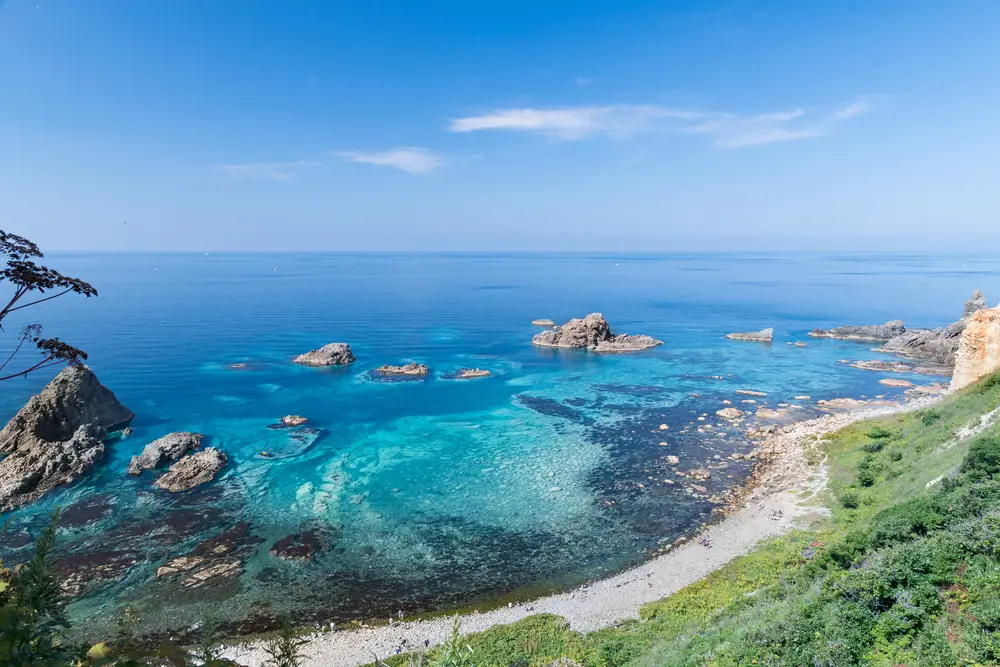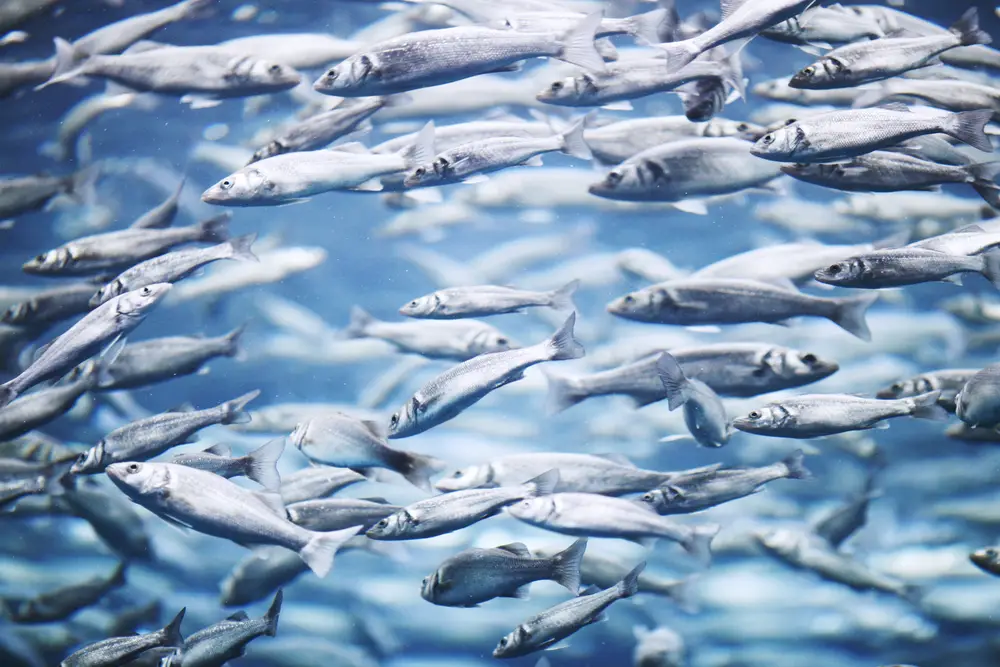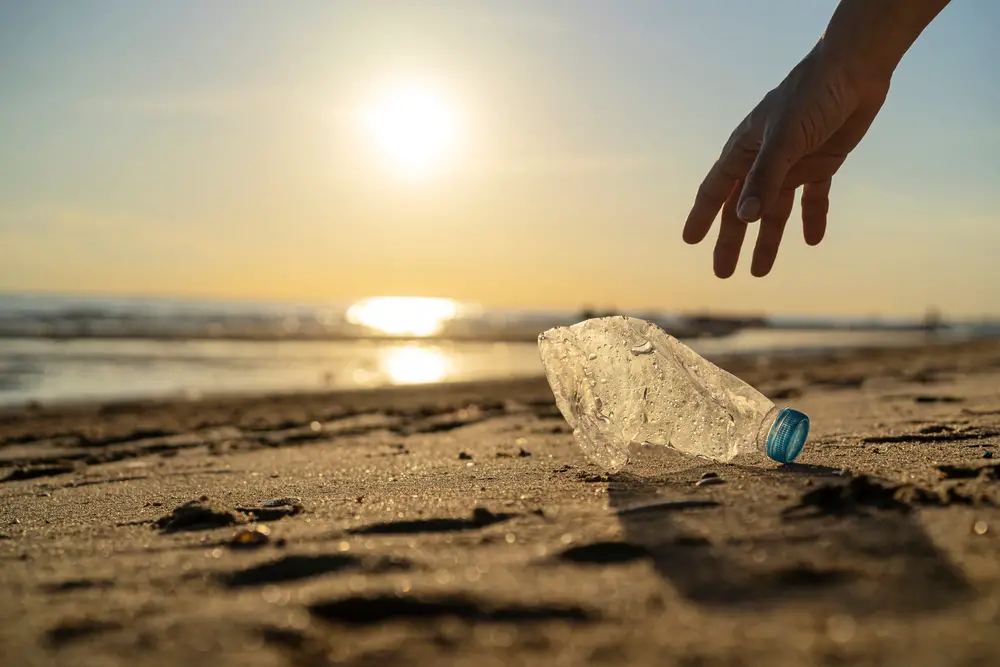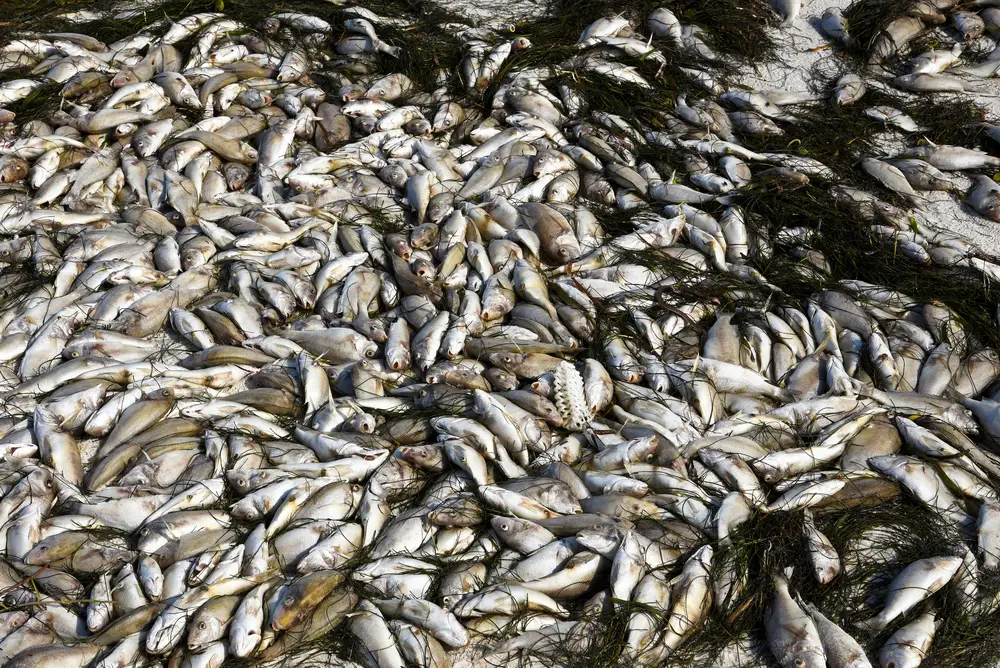Nestled on the scenic coast of Japan’s Hokkaido, the tranquil city of Hakodate recently witnessed an extraordinary and perplexing event that has stirred both locals and environmental experts alike. In a stretch spanning a mile and a half, the once-pristine beach now lies shrouded in a surreal silver blanket of dead fish. This unprecedented occurrence has left the community in a state of bewilderment, prompting urgent advisories against consuming the deceased marine creatures due to the unknown causes of their demise.
A Silent Invasion: The Silver Shores
The sun-kissed shores of Hakodate, once celebrated for their sandy tranquility, have undergone a haunting metamorphosis, shattering the idyllic scene. The beach, where the gentle waves used to caress the golden sands, is now a landscape adorned with the lifeless bodies of thousands of sardines and mackerel.
The silver sheen of their silhouettes creates an otherworldly tableau that defies easy explanation. The once-pristine haven of peace has transformed into an eerie stretch, leaving residents in awe and disbelief. It’s a visual poem of desolation etched across the shores, marking a stark departure from the familiar scenes of serenity.

Community in Disarray: Conversations, Speculations, and Concerns
As the sun dips below the horizon, casting an ethereal glow on the silver shores, the community is left in disarray. Residents, accustomed to the serene beauty of their coastline, now find themselves entangled in conversations that oscillate between speculation and concern. Families strolling along the beach, once a cherished routine, are replaced by hushed discussions about the unusual marine event. The air is thick with questions—how did this happen, and what does it mean for the ecosystem?
The community is collectively striving to understand the origin, scale, and potential repercussions of the dead fish phenomenon. As speculations abound, so do legitimate concerns about the environmental impact and the possible hazards associated with the presence of deceased marine creatures along the once-pristine beach. The sea breeze carries an air of uncertainty, leaving the community yearning for answers in the face of this silent invasion.
The Expert’s Perspective: Unraveling the Mystery
In the heart of the marine mystery stands Takashi Fujioka, a distinguished researcher affiliated with the Hakodate Fisheries Research Institute. Fujioka’s insights delve into the intricate dynamics of marine life, revealing a possible and unexpected explanation for the mysterious event. According to him, the deceased fish might have fallen prey to a relentless pursuit by a larger predator.
This relentless chase could have coerced them into forming densely packed clusters along the beach. In this confined setting, the looming threat of oxygen depletion emerges as a critical factor, potentially sealing the tragic fate of these marine creatures. Fujioka’s perspective opens a window into the underwater drama that unfolded, offering a glimpse into the struggle for survival beneath the surface.
Elusive Identities: The Predator and the Puzzling Events
Fujioka’s explanation, while shedding light on a possible sequence of events, leaves critical questions unanswered, adding an air of mystery to the unfolding narrative. The precise identity of the larger predator remains elusive, casting a shadow of intrigue over the beach’s transformation. The intricacies of the events leading to the mass mortality of the fish, from the initiation of the chase to the final moments on the beach, remain veiled in uncertainty.
Fujioka’s perspective acts as a guidepost, providing valuable insights into the possible mechanisms at play. Yet, the full story of this marine mystery continues to elude both experts and the intrigued community alike. As the community awaits further revelations, the beach, now silent and surreal, echoes with the unheard tales of the deep.
The Seasonal Symphony: Migration and Misfortune
The rhythmic ebb and flow of ocean currents echo the seasonal symphony of marine life, a delicate dance that defines the underwater world. In the intricate choreography of the seas, the southwards migration season of sardines emerges as a pivotal movement, a phenomenon both mesmerizing and integral to the balance of the marine ecosystem. Against this backdrop, the recent aquatic enigma unfolded, casting a shadow on the harmonious rhythm of nature.

As the sun begins its gradual descent, casting warm hues across the ocean, the sardines, like clockwork, embark on their southward migration. This seasonal transition sees vast shoals of these silver-scaled inhabitants navigating the ocean currents with a precision that mirrors the celestial patterns above. It is during this intricate dance of migration that misfortune strikes the shoals, transforming their journey into an unexpected tragedy.
Fujioka’s Insight: Aligning with Nature’s Script
Takashi Fujioka’s perspective aligns seamlessly with the natural script penned by the seasonal migration of sardines. His explanation, rooted in the behaviors and movements of these marine creatures, serves as a key to unraveling the mystery that washed ashore in Hakodate.
Fujioka’s insights suggest that the sardines, caught in a relentless pursuit by a larger predator, found themselves compelled into densely packed clusters. In this tightly-knit formation, the looming threat of oxygen depletion became a tragic reality, sealing the fate of thousands.
Veiled Mysteries: The Predator’s Role and Uncharted Mechanisms
While Fujioka’s expertise unveils a portion of the story, crucial chapters remain veiled in the mysteries of the deep. The identity of the larger predator, a key player in this underwater drama, lingers as an enigma, leaving experts and the intrigued community yearning for revelations.
As the sardines migrated, their journey took an unforeseen turn, one where the predator’s role and the exact mechanisms triggering the mass mortality defy straightforward explanations. The southwards migration season, marked by its innate beauty, also became a witness to the misfortunes hidden beneath the surface, adding complexity to the narrative of the Hakodate beach phenomenon.
Echoes of Concern: Environmental Impact
Fujioka’s concerns transcend the immediate shores, delving into the potential ramifications echoing within the marine ecosystem. The aftermath of the surreal silver shores is not confined to the visual spectacle; it extends beneath the surface, where the decomposing bodies of the sardines and mackerel unveil a silent but potent environmental impact. As these organic remnants break down, a complex chain of consequences is set in motion, with the potential to disturb the delicate balance of marine life in the region.
Oxygen Depletion and Ecosystem Vulnerability
One of the primary environmental concerns highlighted by Fujioka is the impact of decomposing fish bodies on oxygen levels in the surrounding waters. The breakdown of organic matter consumes oxygen, and in a confined aquatic environment, this process can lead to significant depletion.
The consequences reverberate through the intricate web of marine life, affecting not only the fish but also other organisms dependent on adequate oxygen levels for survival. The silent invasion of the silver shores becomes a catalyst for potential shifts in the ecosystem, raising questions about its resilience in the face of unexpected events.
Puzzling Possibilities: Exploring Alternatives
While Fujioka’s theory sheds light on a predator-driven scenario, the complexity of marine ecosystems opens avenues for exploring alternative explanations. Fluctuations in water temperature, changes in pollution levels, or the disruptive influence of natural calamities present a tapestry of possibilities that scientists and marine biologists are diligently unraveling. Each factor represents a puzzle piece in the broader narrative of the mass fish die-off, prompting a comprehensive exploration into the multifaceted nature of the event.
Temperature Fluctuations: A Key Player?
Among the puzzling possibilities, shifts in water temperature emerge as a potential key player. The delicate balance of marine life is intricately tied to specific temperature ranges, and deviations can trigger a cascade of events.
A meticulous examination of temperature variations in the region during the period of the incident becomes imperative, offering insights into whether thermal factors played a role in the tragedy that unfolded on Hakodate’s shores.
Pollution and Natural Disasters: Uncharted Influences
The investigation extends beyond temperature, encompassing the broader realms of pollution and natural calamities. Elevated pollution levels, whether from anthropogenic sources or natural phenomena, could have contributed to the distressing event.

Similarly, seismic activities or underwater volcanic disturbances might have disrupted the marine ecosystem, amplifying the challenges faced by the migrating sardines. Scientists, armed with data and analyses, navigate the complexities of these environmental factors, piecing together a comprehensive understanding of the forces at play in this inexplicable episode.
Beyond Hakodate: Historical Echoes of Similar Events
While Hakodate grapples with the enigma unfolding on its shores, a glance into the pages of history unveils a recurring theme of mass fish die-offs across the globe. These phenomena, echoing the current events in Hakodate, transcend geographic boundaries and find parallels in the tales of other coastal communities.
Notably, the notorious Red Tide, fueled by harmful algal blooms, has inscribed its presence in historical records, orchestrating large-scale fish mortality. The resonance with such global instances raises questions about the interconnectedness of marine ecosystems and the shared vulnerabilities that transcend individual locations.
Hypoxia’s Silent Assault: A Historical Perspective
Beyond the specter of the Red Tide, historical records bear witness to fish kills orchestrated by hypoxia, an ominous phenomenon marked by low oxygen levels in the water. The roots of hypoxia-induced fish mortality delve into diverse causes, ranging from pollution to nutrient runoff and the unchecked proliferation of algae. As history echoes with instances of coastal waters witnessing an unsettling dance of fish succumbing to oxygen-deprived environments, the parallels with Hakodate’s current plight underscore the timeless challenge of safeguarding marine ecosystems.
Navigating Uncharted Waters: Dealing with a Fish Apocalypse
As Hakodate stands at the forefront of an ecological conundrum, it beckons a collective response to navigate these uncharted waters. The community, hand in hand with authorities, holds the key to addressing and understanding the fish apocalypse unfolding on its shores. Prompt reporting of such incidents becomes a linchpin for initiating thorough investigations and establishing robust monitoring mechanisms. The historical echoes of similar events around the world serve as a poignant reminder that ecological anomalies demand a unified and vigilant response, transcending local boundaries for the greater good of marine ecosystems.
Cautionary Measures: Preserving Health and Environment
In the wake of the unprecedented event, a set of cautionary measures emerges as a beacon of guidance. Both locals and authorities play pivotal roles in ensuring the mitigation of potential health risks and minimizing the environmental impact. A crucial facet involves refraining from the consumption or sale of dead fish found on the beach, acknowledging the unknown causes of death and the risk of contamination. This collective responsibility becomes a cornerstone in the broader effort to preserve not only the health and safety of individuals but also the delicate equilibrium of the marine environment.
Building Awareness: Safeguarding Ecological Harmony
Hakodate’s encounter with a marine mystery becomes a clarion call for building awareness and fostering an understanding of the intricate relationships within marine ecosystems.
Education and outreach programs, guided by the lessons learned from historical parallels, become essential tools for instilling a sense of responsibility and ecological stewardship. As the community and authorities navigate these uncharted waters, the proactive dissemination of knowledge becomes a potent force in safeguarding the delicate balance between human activities and the natural world.
Engaging in citizen science efforts, residents can contribute valuable insights by reporting any unusual observations or abnormalities in marine life. Collaborating with scientific organizations and research institutions, this collective vigilance aids in building a comprehensive understanding of marine ecosystems and facilitates early detection of potential threats.
Tips for Dealing with a Fish Die-Off
You can aid in the protection of our oceans and their inhabitants by following this collaborative approach, which ensures a more comprehensive understanding of marine ecosystems.
- Immediate Reporting: Report any unusual observations promptly to local authorities or environmental agencies.
- Avoid Consumption: Refrain from consuming or selling dead fish found on the beach, as unknown causes of death may pose health risks.
- Follow Guidelines: Adhere to guidelines or advisories issued by local authorities regarding water safety and seafood consumption.
- Responsible Disposal: Never dispose of dead fish or marine life in bodies of water, as this can worsen environmental impact and endanger other species.
- Citizen Science: Contribute to citizen science efforts by reporting observations to relevant scientific organizations or research institutions.
The Depths Unveiled: Ongoing Research and Implications
The mysterious event of dead fish carpeting Hakodate’s shores remains an enigma, inviting both awe and concern. While scientific explanations offer glimpses into the possible causative factors, the full narrative is still unwritten.
Ongoing research endeavors strive not only to unveil the intricacies of this peculiar event but also to comprehend its broader implications for marine ecosystems.
As we plunge into the depths of this aquatic mystery, we embark on a journey to safeguard the delicate balance of our underwater world, armed with knowledge and a commitment to preserving the wonders that lie beneath the surface.
Sources:
As speculations abound, so do legitimate concerns about the environmental impact.
Takashi Fujioka’s perspective aligns seamlessly with the natural script.
The roots of hypoxia-induced fish mortality delve into diverse causes.
Acknowledging the unknown causes of death and the risk of contamination.

This Site Was Inspired By An Interest in Protecting the Environment:
We had the privilege and joy of learning from Dr. Charlie Stine who instilled a love for the natural world through incredible field trips with the Johns Hopkins Odyssey Certificate program in Environmental Studies. At the time, the program was endorsed by the Maryland Department of Natural Resources. Sadly, after Dr. Stine retired, the program was phased out. We hope that we honor his legacy by shining a bright light on environmental issues and sharing good news about the success of various conservation programs when possible.

